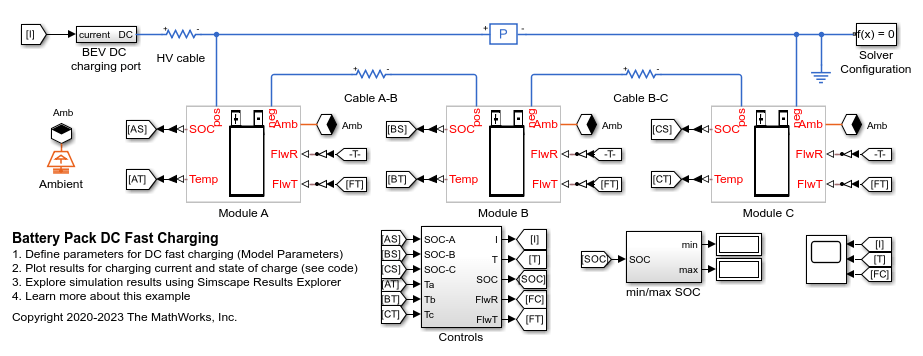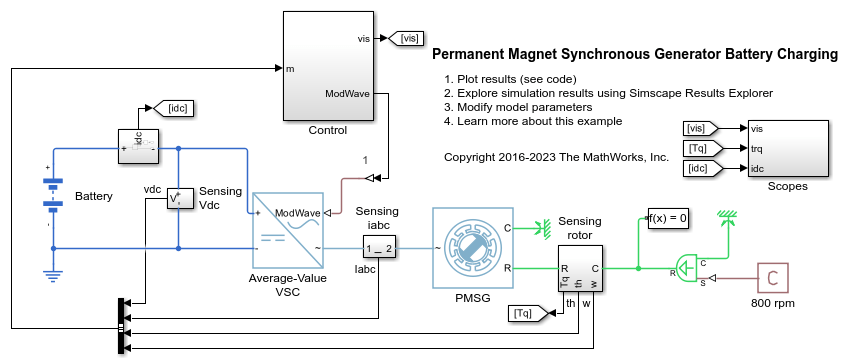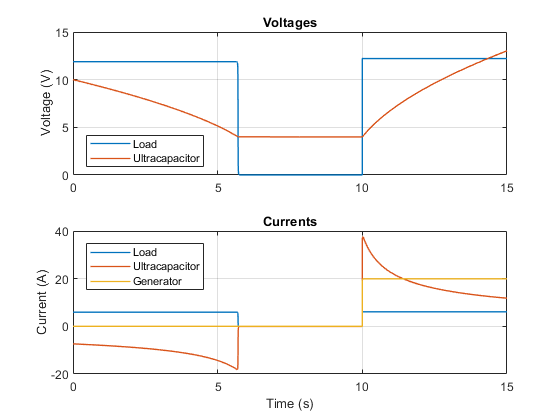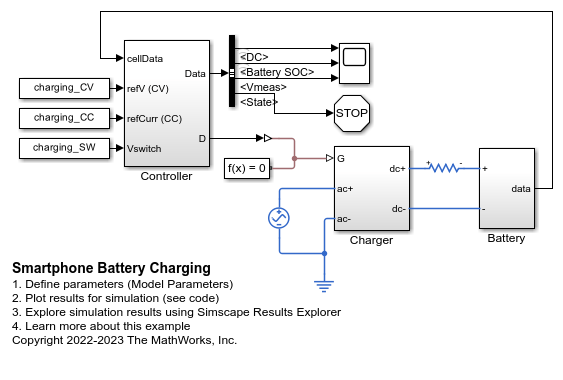Energy Storage
Use these examples to learn how to store energy through batteries and capacitors.
Featured Examples
HV Battery Charge/Discharge
A high-voltage battery like those used in hybrid electric vehicles. The model uses a realistic DC-link current profile, which originates from a dynamic driving cycle. The total simulation time is 3600 seconds.
Battery Pack Cell Balancing
Implement a passive cell balancing for a Lithium-ion battery pack. Cell-to-cell differences in the module create imbalance in cell state of charge and hence voltages. In this example, the balancing algorithm starts when the battery pack is idle and the difference in the cell state of charge is above a certain predefined value.
Battery Pack Thermal Management
Model an automotive battery pack for thermal management tasks. The battery pack consists of several battery modules, which are combinations of cells in series and parallel. Each battery cell is modeled using the Battery (Table-Based) Simscape™ Electrical™ block. In this example, the initial temperature and the state of charge are the same for all cells. Four battery modules, three similar and one differing from the other three, are connected in series to simulate a battery pack. The results in this example assume an initial ambient temperature equal to 25 degree Celsius. The Coolant Controls subsystem defines the logic used to determine the battery pack coolant flow rate.
Battery Pack DC Fast Charging
Model an automotive battery pack for DC fast charging tasks. The battery pack consists of several battery modules, which are combinations of cells in series and parallel. Each battery cell is modeled using the Battery (Table-Based) Simscape Electrical block. In this example, the initial temperature and the state of charge are the same for all cells. The cell capacity varies according to the manufacturing tolerances or uncertainties. Three battery modules, two similar and one differing from the other two, are connected in series to simulate a battery pack. The results in this example assume an initial ambient temperature equal to zero degree Celsius. The Controls subsystem defines the logic to determine the battery pack charging time and current.
Battery Pack Short Circuit
Model a short-circuit in a lithium-ion battery module. The battery module consists of 30 cells with a string of three parallel cells connected in a series of ten strings. Each battery cell is modeled using the Battery (Table-Based) Simscape Electrical block. In this example, the initial temperature and the state of charge are the same for all cells. There is no coolant flow modeled in this example. The battery module is shorted with a 0.1mOhm resistor. There is an inrush current followed by cell quick discharge and heating up. Once the cell reaches the trigger temperature for thermal runaway and cell venting, the electrical circuit is disconnected to stop the electrical simulation.
Permanent Magnet Synchronous Generator Battery Charging
Use a permanent magnet synchronous generator (PMSG) to charge a battery. An ideal angular velocity source is used to maintain the rotor speed constant. The Control subsystem uses field oriented control to regulate the torque of the PMSG. The torque reference is obtained as a function of dc-link voltage. The initial battery state of charge is 25%. The Scopes subsystem contains scopes that allow you to see the simulation results.
Supercapacitor Charging and Discharging Behavior
The voltage output by a Supercapacitor block as it is charged and then discharged. To charge the Supercapacitor, a current of 100 mA is input to the Supercapacitor for 100 seconds. The Supercapacitor is then rested for one minute. For the next hour, to discharge the Supercapacitor, a load of 50 mA is stepped on for one second in every 50 seconds. The Supercapacitor is then rested until the end of the simulation. The scope displays the Supercapacitor charging/discharging current and voltage.
Ultracapacitor with Converter
Use a DC-DC converter to maintain a constant load voltage when drawing power from an ultracapacitor. The converter supplies power to the load and the capacitor voltage drops. The protection circuit disconnects the load when the capacitor voltage drops below a threshold value of 4V. At 10 seconds, the generator turns on, supplies power to the load and charges back the capacitor.
Smartphone Battery Charging
Set up a constant current (CC) and constant voltage (CV) charging on a typical battery in a smartphone. A constant current starts charging the battery. When the battery voltage reaches a specific value, the constant voltage charging process starts.
Battery Pack Fault Protection
Model fault and fault protection using a fuse in an automotive battery pack. The battery pack consists of several battery modules, which are combinations of cells in series and parallel. Each battery cell is modeled using the Battery (Table-Based) Simscape Electrical block. In this example, the initial temperature and the state of charge are the same for all cells. Four battery modules, three similar and one differing from the other three, are connected in series to simulate a battery pack. The results in this example assume an initial ambient temperature equal to 25 degree Celsius. The Control subsystem defines the logic used to determine the battery pack coolant flow rate. A fuse is placed inline to battery pack as a measure of fault protection.
Peak Shaving with Battery Energy Storage System
Model a battery energy storage system (BESS) controller and a battery management system (BMS) with all the necessary functions for the peak shaving. The peak shaving and BESS operation follow the IEEE Std 1547-2018 and IEEE 2030.2.1-2019 standards.
MATLAB Command
You clicked a link that corresponds to this MATLAB command:
Run the command by entering it in the MATLAB Command Window. Web browsers do not support MATLAB commands.
Select a Web Site
Choose a web site to get translated content where available and see local events and offers. Based on your location, we recommend that you select: .
You can also select a web site from the following list
How to Get Best Site Performance
Select the China site (in Chinese or English) for best site performance. Other MathWorks country sites are not optimized for visits from your location.
Americas
- América Latina (Español)
- Canada (English)
- United States (English)
Europe
- Belgium (English)
- Denmark (English)
- Deutschland (Deutsch)
- España (Español)
- Finland (English)
- France (Français)
- Ireland (English)
- Italia (Italiano)
- Luxembourg (English)
- Netherlands (English)
- Norway (English)
- Österreich (Deutsch)
- Portugal (English)
- Sweden (English)
- Switzerland
- United Kingdom (English)










